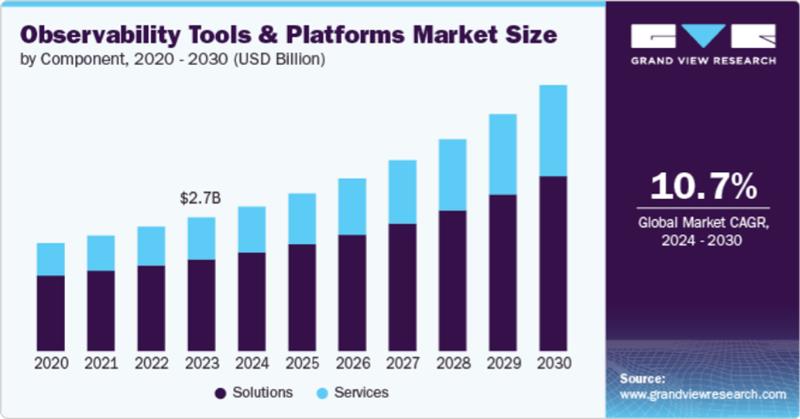Recommended Blogs

Mastering Cloud Observability: Hidden Advantage for Performance and Resilience
Table of Content
In the race to master the cloud, complexity is the real opponent. Today’s leading enterprises often juggle 10–20+ observability tools to keep systems running at peak performance. Traditional monitoring is no longer enough; modern environments demand real-time, full-stack insight.
Cloud observability empowers teams to detect issues before they escalate, optimize resources, and ensure unwavering resilience. But with so much data, the real challenge is knowing which tools and strategies cut through the noise.
This blog will show you how to conquer that complexity, choose the right observability approach, and turn insight into decisive action.
Why Observability is No Longer Optional?
In todays distributed cloud environments, the ability to interpret state of internal systems by observing and analysing the external outputs is a distinct advantage. The traditional monitoring is not enough.
Observability Offers:
- The run time observations and corelated insights into the interplay of applications, cloud services and infrastructure.
- Proactive and pre emptied issue detection before they impact users or initiate a churn
- Visibility through the entire technology stack Full-stack. This helps in a comprehensive view and interlinkages, specially around the Root Cause Analysis.
The digital shift is driving humongous data, including synthetic data. The observability tools market is projected to grow at a CAGR of 10.7% from 2024 to 2030. The leading organisations are betting on observability for their ability to predict the future breakdowns, instead of reacting when they occur.
Role of Observability in Enhancing Cloud Performance
Observability is very important for improving cloud performance since it gives clear, actionable information about cloud systems. With complicated distributed architectures, being able to see every layer of the cloud environment makes it easy for teams to find performance problems, make the most use of resources, and keep the system reliable. Here is how observability enhances cloud performance:
1. Comprehensive Visibility
Leading organisations are pushing the bar for excellence and performance optimisation. The comprehensive view and interplay of microservices, databases, and networks, eliminates the blind spots. This makes troubleshooting faster and performance optimization more impactful, capturing wins across a multitude of nodes.
2. Predictive Detection of Performance Issues
By continuously analysing the telemetry data, organisations can arrest rising latency and the breakdowns. The mean time between failure is also observed and pre emptied before there become outages. Unified dashboards ensure that all hands are on the deck and the developers, operations, and security teams work from the same source of truth, giving a better coordinated view of the realities and the dependencies.
3. Compliance, Security and Scalability
The increasingly stringent governance and regulations like GDPR and HIPPA need faster and comprehensive anomaly detection and observability strengthens the same. It also helps detect over provisioning and cost optimisation, aiding in responsive capacity building and cost attribution. Observability platforms are built to respond effectively to the e growing data volumes, evolving architectures, and multi-cloud environments—without compromising performance.
Tools and Technologies to Enhance Cloud Observability
Companies need to use various tools and technologies to make cloud observability work. These tools allow you to collect, analyze, and show the critical metrics, logs, and traces that give you a clear picture of what’s going on in cloud environments. Some of the most important tools include:
- Application Performance Monitoring (APM): Datadog, New Relic, AppDynamics
- Log Management & Analysis: Elastic Stack, Splunk, Loggly
- Infrastructure Monitoring: Prometheus, Nagios, Zabbix
- Distributed Tracing: Jaeger, Zipkin, AWS X-Ray
- Synthetic Monitoring: Pingdom, Catchpoint, Uptrends
- Cloud-Native Monitoring: Amazon CloudWatch, Google Stackdriver
- Data Visualization: Grafana, Kibana, Power BI
How TxMinds Helps Achieve Advanced Cloud Observability
We assist businesses in getting advanced cloud observability at TxMinds by putting together the right technologies to make sure they can see everything in all of their cloud settings. Integrating real-time analytics, APM, infrastructure monitoring, and distributed tracing, we help our clients form a cohesive strategy.
Our approach ensures:
- End-to-end visibility across all cloud environments across the enterprise.
- Proactive detection and resolution of performance and excellence bottlenecks
- Responsive resource allocation to reduce costs and boost efficiency
- Actionable insights through unified dashboards and advanced visualizations
With TxMinds, observability becomes a scalable strategic advantage, not just a technical necessity.
Summary
Businesses need cloud observability to maintain their performance and resilience in complicated cloud settings. Businesses may find and fix problems before they happen by utilizing observability tools to watch and analyze application and infrastructure data in real time. It makes sure that services are delivered without any problems. Companies may increase performance and resilience by optimizing resource allocation, improving collaboration, and making systems more reliable with full-stack visibility and data-driven insights.
FAQs
-
Cloud observability is the ability to keep an eye on and study cloud infrastructure and applications by gathering information like logs, metrics, and traces. It explains how well the system works and helps find problems before they affect users.
-
Traditional monitoring looks at set metrics and warnings, while cloud observability gives teams more information by letting them examine and analyze data to understand why systems behave the way they do.
-
When businesses employ cloud observability, they can see everything about their systems. This makes it easier to fix problems, improves user experiences, better uses resources, and strengthens security and compliance.
-
Observability tools include APM, infrastructure, log management, distributed tracing, and synthetic monitoring tools, each providing different layers of visibility into cloud systems’ performance.
Discover more
Stay Updated
Subscribe for more info





